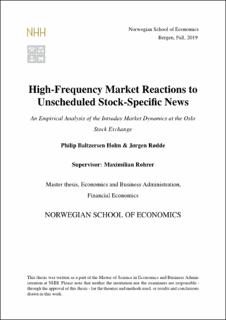| dc.description.abstract | We use pre-processed news data combined with high-frequency stock data from the Oslo Stock
Exchange to test the following hypotheses: (1) the sentiment of news articles can predict the
direction of intraday abnormal returns; and (2) intraday volatility and trading activity increase
around the arrival of news articles. First, we find that abnormal returns are significantly negative
at 17 basis points 90 minutes after a negative news release. In contrast, we cannot establish a
significant relationship between abnormal returns and news with a positive or neutral sentiment.
Second, by using a high-frequency vector autoregressive model, we find that: (1) volatility
increase on average 0.47 standard deviations ten minutes before a news arrival; and (2) money
value traded increase by 0.48 and 0.47 standard deviations five and ten minutes before news
arrivals. Thus, our results suggest that negative news articles affect the abnormal returns more
than positive news articles and that unscheduled news affects the intraday volatility and trading
activity at the Oslo Stock Exchange. | en_US |
